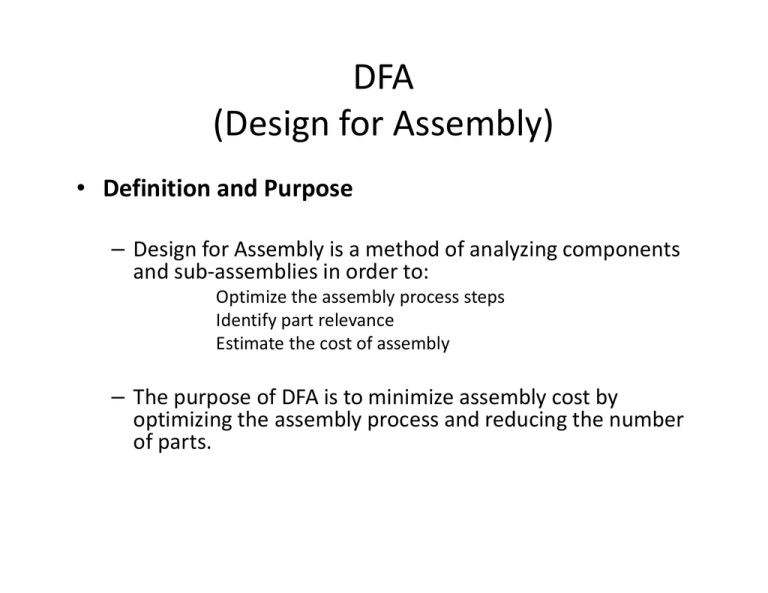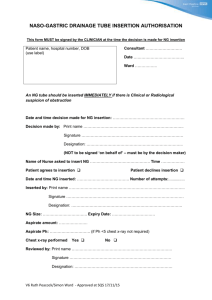Design for Assembly (DFA) Presentation
advertisement

DFA (Design for Assembly) • Definition and Purpose – Design for Assembly is a method of analyzing components and sub-assemblies in order to: Optimize the assembly process steps Identify part relevance Estimate the cost of assembly – The purpose of DFA is to minimize assembly cost by optimizing the assembly process and reducing the number of parts. DFA Process • Prior to examining a system for DFA you need – a model, drawing or prototype of the assembly – a proposed assembly sequence. Examine Assembly Steps • Part handling • Part insertion/orientation • Non-value added process steps Examine Part Relevance • Minimize part count • Determine theoretical minimum number of parts • Minimize the levels of assembly Part Handling • Design parts that are easy to handle • Alpha/Beta angle symmetry – Alpha: axis perpendicular to direction of insertion – Beta: axis in direction of insertion Part Handling • Geometric Size – Design parts that are “ideal” in terms of size – Large parts • Require two hands • Require mechanical assistance – Tiny parts • Require tweezers • Require magnification Part Handling • If possible, minimize – Flexible parts (wiring, tubing, gaskets) • difficult handling – Parts that tangle – Slippery or sticky parts • (pre-lubricated, pre-adhesive) – Parts with sharp edges or points Part Insertion Design for uni-directional assembly, preferably using gravity Assembly to a stable base Part Insertion Design parts that are easy to align and position, design parts that self-fixture. Part Insertion Consider access and visibility for ease of insertion. Part Insertion Design parts that self align Mistake Proofing Issues (Poka-Yoke) • Cannot assemble wrong part • Cannot omit part • Cannot assemble part wrong way around. symmetrical parts asymmetrical parts Part Insertion Avoid the need for adjustments and reorientations during assembly Use unidirectional assembly where possible Minimize Part Count • Design for the minimum number of without sacrificing quality. • Fewer parts mean – a faster and more accurate assembly process – it results in: • Reduced inventory and number of vendors • Reduced assembly time and savings in material costs • Simplified assembly processes • It can be accomplished by: • • • • Minimizing numbers and types of fasteners, cables, etc. Encouraging modular, interchangeable assemblies Building in self-fastening features Minimizing the number of levels of assembly Eliminating Parts Avoid separate fasteners: design the fastening functions into the parts. Eliminating Fasteners Fastener Cost • Select the most inexpensive fastening method required screwing riveting plastic bending snap fit Self-Fastening Features Theoretical Number of Parts 1) Is the component/sub-assembly used only for fastening or securing other items? If yes, try to eliminate. 2) Is the component/sub-assembly used only for connecting other items (for example, wiring harnesses, belts, chains)? If yes, try to eliminate. 3) During operation, does the component move relative to all other parts already assembled? If no, skip question #4 4) Must the part be made of a different material than, or isolated from all other parts already assembled? Only fundamental reasons concerned with material properties are acceptable. If no, go to question #5 5) Must the part be separate from all other parts already assembled because of any necessary assembly or disassembly of the other parts would otherwise be impossible? If no to questions #3-5, part is theoretically unnecessary. 6) If this is a part in a sub-assembly, can any part be combined with another part in the parent assembly? Three solutions to the same design issue. Comments? Which do you prefer? Why? DFA Software • Will allow user to see the effects of part handling decisions. • Will help user to work toward minimizing part count.




